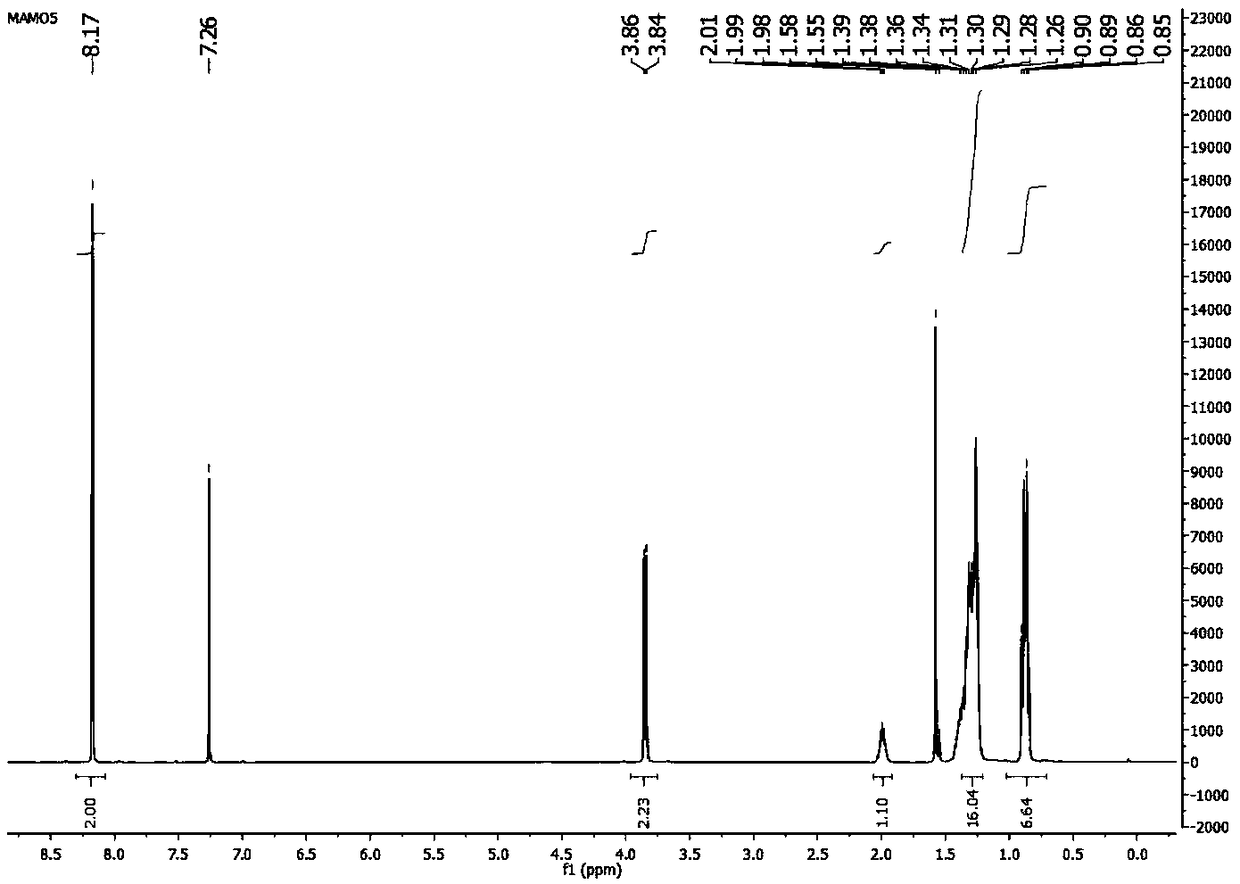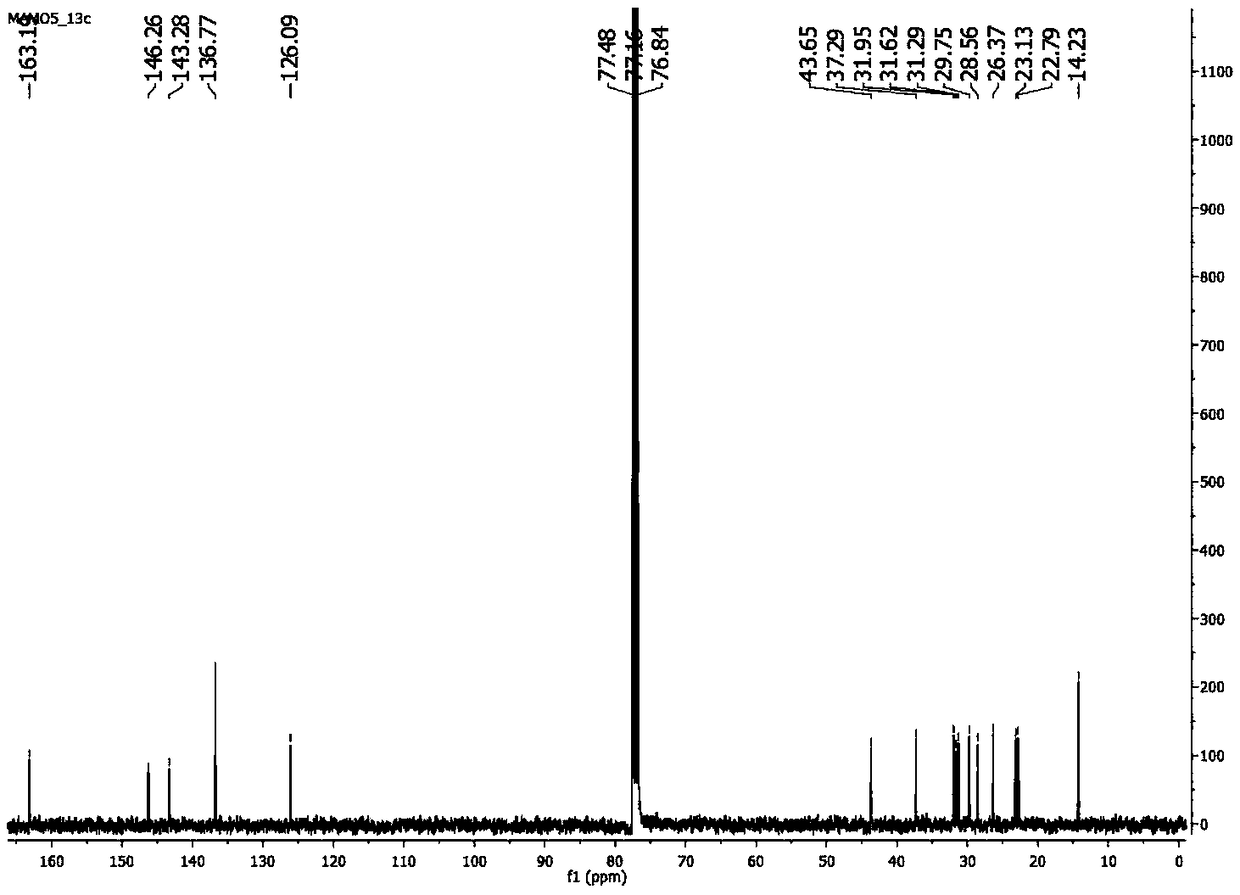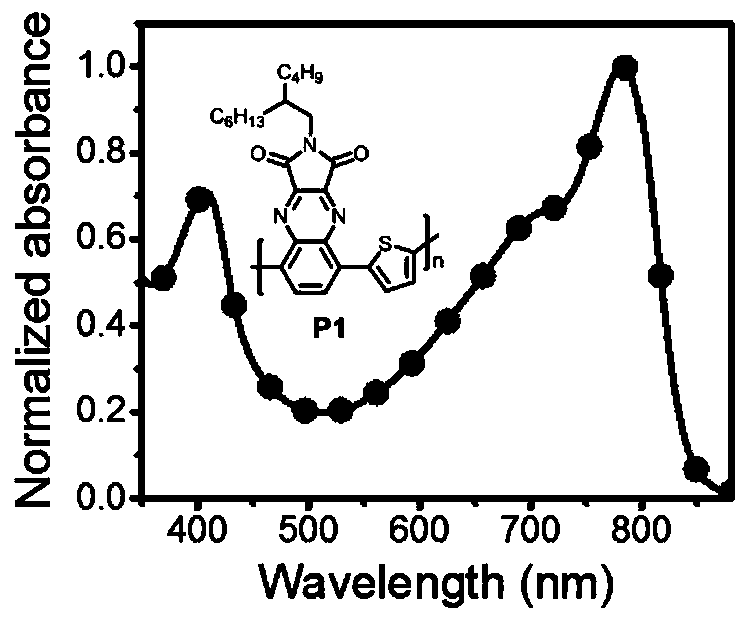Conjugated polymer photoelectric material containing quinoxaline imide condensed ring and application thereof
A quinoxaline imide condensed ring and conjugated polymer technology, which is applied in the field of conjugated polymer photoelectric materials, can solve the problems of limited application range and low polymer energy level, and achieve strong electron-deficiency and effective absorption and the effect of using
- Summary
- Abstract
- Description
- Claims
- Application Information
AI Technical Summary
Problems solved by technology
Method used
Image
Examples
Embodiment 1
[0045] Preparation of Polymer Optoelectronic Material Poly[5,8-2-Alkylquinoxalinoimide-2,5-thiophene] (abbreviated as P1)
[0046] The synthetic route is as follows:
[0047]
[0048] (1) Synthesis of 3,6-dibromo-1,2-o-phenylenediamine:
[0049] Dissolve 5.88g of 4,7-dibromo-2,1,3-benzothiadiazole 4 in 200mL of ethanol, cool with ice water, and add 14.0g of sodium borohydride in batches. After reacting for 6h, pour into ice brine and filter with suction. After drying, 2.44 g of yellow flaky solid 3,6-dibromo-1,2-o-phenylenediamine 5 was obtained, with a yield of 46%.
[0050] (2) Synthesis of 5,8-dibromo-2-alkylquinoxaline imide (the alkyl group is 2-butyloctyl):
[0051] Dissolve 2.65g of 3,6-dibromo-1,2-o-phenylenediamine in 50mL of acetic acid, add 0.72g of sodium acetate and 3.8g of alkylpyrrole-2,3,4,5-tetraketone (3), Heated to reflux for 24h. The reaction solution was poured into ice-salt water, dichloromethane was added under stirring for extraction, the organi...
Embodiment 2
[0057] Preparation of Polymer Optoelectronic Material Poly[5,8-2-Alkylquinoxalinoimide-2,5-3,4-Difluorothiophene] (abbreviated as P2)
[0058] Synthesis of poly[5,8-2-alkylquinoxaline imide-2,5-3,4-difluorothiophene] (referred to as P2):
[0059] Under an argon atmosphere, 616mg of 5,8-dibromo-2-alkylquinoxalimide, 447mg of 2,5-bis(trimethyltinyl)-3,4-difluorothiophene, 4.5mg Tris(dibenzylideneacetone)dipalladium (Pd2(dba)3) and 9.0 mg of tris(o-methylphenyl)phosphorus (P(o-Tol)3) were dissolved in a mixed solvent of 10 mL of toluene and 5 mL of tetrahydrofuran. Under the protection of argon, the reaction was refluxed for 20 h. After cooling to room temperature, the reaction liquid was dropped into 300 mL of methanol for precipitation, and a blood-red solid was obtained by filtration. After extracting with acetone, methanol, n-hexane, and dichloromethane in a Soxhlet extractor for 24 hours, the polymer was finally washed with chloroform, cooled and filtered through a 0.45 μm ...
Embodiment 3
[0062] Example 1 and Example 2 synthesized polymers P1, P2 illustrate that such polymers can be used as N-type or polymer acceptors in polymer solar cell devices (ITO cathode / cathode interface layer / active layer / Yang machine interface layer / anode):
[0063] Pre-cut the ITO conductive glass with a square resistance of 20 ohms / cm2 into 15mm×15mm square pieces. Use acetone, special detergent for micron-sized semiconductors, deionized water, and isopropanol to clean ultrasonically in sequence, blow nitrogen whistle, and place in a constant temperature oven for later use. Spin-coat a layer of PFN-Br with a thickness of 5nm on the ITO, then spin-coat the active layer materials PTB7-Th / P1, PTB7-Th / P2 with a thickness of about 100nm, and finally evaporate MoO 3 and Al electrodes. All preparations were carried out in a glove box under a nitrogen atmosphere. The current-voltage curves of the fabricated flip-chip devices are as follows: Figure 6 The relevant data are listed in Ta...
PUM
 Login to View More
Login to View More Abstract
Description
Claims
Application Information
 Login to View More
Login to View More - R&D
- Intellectual Property
- Life Sciences
- Materials
- Tech Scout
- Unparalleled Data Quality
- Higher Quality Content
- 60% Fewer Hallucinations
Browse by: Latest US Patents, China's latest patents, Technical Efficacy Thesaurus, Application Domain, Technology Topic, Popular Technical Reports.
© 2025 PatSnap. All rights reserved.Legal|Privacy policy|Modern Slavery Act Transparency Statement|Sitemap|About US| Contact US: help@patsnap.com



